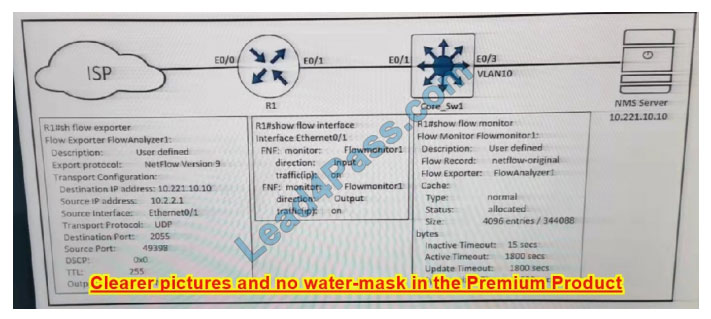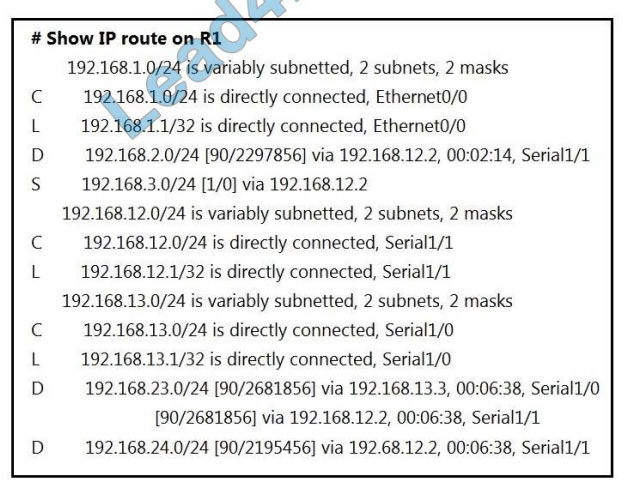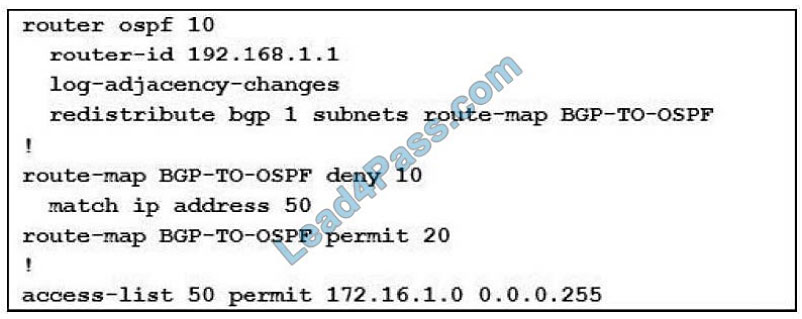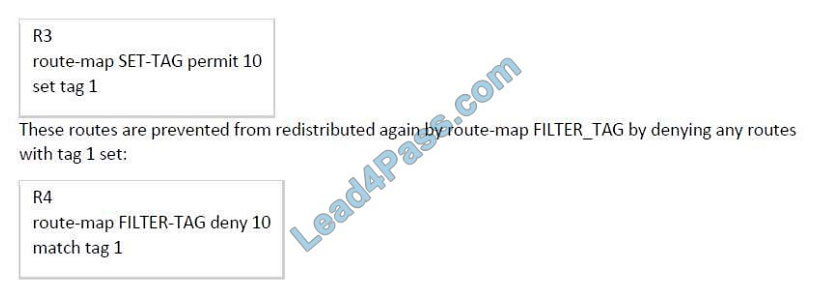leads4pass 300-410 dumps contain 807 latest exam questions and answers, which is currently the most suitable exam study material for candidates! Because leads4pass is the most cost-effective and provides flexible learning solutions in both PDF and VCE formats!
And each update will share an online exercise, the most important thing is to share for free! So candidates can freely choose to practice for free to improve their strength, or directly download the latest updated leads4pass 300-410 dumps: https://www.leads4pass.com/300-410.html
Help you 100% succeed.
Using PDF or VCE:
leads4pass 300-410 dumps include PDF and VCE learning formats, you can choose any according to your learning habits!
300-410 dumps PDF: Contains the latest exam questions and answers, the file is portable for all systems and browsers
300-410 dumps VCE: Provides online practice tests, timing, and explanations of difficult problems, and most of the questions are illustrated with text to ensure that you can learn easily
leads4pass is an open and inclusive website, we will distribute some free 300-410 exam questions and answers from time to time for your online exam practice test:
| From | Number of exam questions | Exam name | Exam code | Last updated |
| leads4pass | 13 | Implementing Cisco Enterprise Advanced Routing and Services (ENARSI) (Include 2023 Newest Simulation Labs) | 300-410 | 300-410 dumps |
QUESTION 1:
Refer to the exhibit. An engineer configured IP SLA on R1 to avoid the ISP link flapping problem, but it is not working as designed. IP SLA should wait 30 seconds before switching traffic to a secondary connection and then revert to the primary link after waiting 20 seconds when the primary link is available and stabilized.

R1# *Nov 18 15:38:59.956: track-sta (700) Change #8 ip sla 700, state Up -> Down *Nov 18 15:38:59.956:
%TRACK-6-STATE: 700 ip sla 700 state Up -> Down *Nov 18 15:38:59.956: track-sta (700) ip sla 700 state Up -> Down
*Nov 18 15:38:59.956: track-que (700) Queuing CHANGED client event for Static IP Routing *Nov 18 15:38:59.956:
track-que (700) Unqueuing CHANGED client event for Static IP Routing *Nov 18 15:39:04.965: track-sta (700) Change
9 ip sla 700, state Down -> Up *Nov 18 15:39:04.965: %TRACK-6-STATE: 700 ip sla 700 state Down -> Up *Nov 18
15:39:04.965: track-sta (700) ip sla 700 state Down -> Up *Nov 18 15:39:04.965: track-que (700) Queuing CHANGED client event for Static IP Routing *Nov 18 15:39:04.965: track-que (700) Unqueuing CHANGED client event for Static IP Routing

Which configuration resolves the issue?
A. R1(config)#track 700 ip sla 700 R1 (config-track)#delay down 30 up 20
B. R1 (config)#ip sla 700 R1(config-ip-sla)#delay down 30 up 20
C. R1 (config)#ip sla 700 R1(config-ip-sla)#delay down 20 up 30
D. R1(config)#track 700 ip sla 700 R1(config-track)#delay down 20 up 30
Correct Answer: A
“wait 30 seconds before switching traffic to a secondary connection” -> delay down 30
“then revert to the primary link after waiting 20 seconds” -> up 20 Under the tracked object, you can specify delays so we have to configure delay under “track 700 ip sla 700” (not under “ip sla 700”).
QUESTION 2:
The exhibit is a frame relay hub-and-spoke topology with router A as the hub.

You want to use the OSPF routing protocol between all three locations. Which interface configuration commands are required on router A? (Choose three.)
A. ip ospf network broadcast
B. ip ospf network point-to-point
C. ip ospf network point-to-multipoint
D. frame-relay map 10.20.10.21 221
E. frame-relay map 10.20.10.22 222
F. frame-relay map ip 10.20.10.21 221 broadcast
G. frame-relay map ip 10.20.10.22 222 broadcast
Correct Answer: CFG
In OSPF point-to-multipoint mode, the routers will automatically identify each neighbor. The election of a designated router (DR) and backup designated router (BDR) are not required.
This RFC-compliant mode of operation is commonly found in partial mesh topologies, such as hub-and-spoke designs. In the diagram shown in the scenario, router A is the hub.
The frame relay serial interface has one DLCI for each spoke location. DLCI 221 is used by router A to communicate with router C and DLCI 222 is used to communicate with router B. On the router, A\’s serial interface, the point-to-multipoint mode is enabled with the ip ospf network configuration command. The following is the syntax of the ip ospf network command:
ip ospf network [{broadcast | nonbroadcast | point-to-multipoint | point-to-multipoint nonbroadcast}]
The command parameters are as follows:
broadcast – This mode enables the interface to emulate a LAN. This mode requires a full or partial mesh topology.
nonbroadcast – This RFC 2328 compliant mode is also referred to as NBMA mode. The neighbors must be statically configured.
point-to-multipoint – This RFC 2328 compliant mode is used in partial mesh topologies, such as hub-and-spoke.
Routers use additional LSAs to discover neighboring routers instead of manually defining DRs and BDRs.
The hub router floods
link state updates (LSUs) by duplicating the update to be sent to each router using the respective DLCI.
point-to-multipoint nonbroadcast – This is a Cisco extension to the point-to-multipoint mode.
This mode is useful when the frame relay virtual circuits do not support broadcast traffic. Neighbors are manually defined.
There is no point-to-point parameter for the ip ospf command. Creating a point-to-point configuration differs in that the point-to-point parameter is executed as a parameter of the command that creates the subinterface that hosts the point-to-point connection as shown below:
Router(config)# interface serial 0.1 point-to-point
When configuring a serial interface without sub-interfaces, OSPF will check the encapsulation to determine the network type. HDLC and PPP default to point-to-point while Frame-Relay encapsulation defaults to nonbroadcast.
The frame-relay map command identifies the mapping between the Layer 3 address (IP address) and the Layer 2 address (DLCI). The frame relay virtual circuits from the hub router are identified as supporting broadcast traffic by using the frame-relay map command with the broadcast keyword.
Objective:
Layer 2 Technologies
Sub-Objective:
Explain Frame Relay
References:
Cisco > Home > Support > Support Technology > Support > IP Routing > Configure > Configuration Examples and Technotes > Initial Configurations for OSPF over Frame Relay Subinterfaces Cisco > Cisco IOS Wide-Area Networking Command Reference > frame-relay lap n201 through fr-atm connect dlci > frame-relay map
QUESTION 3:
You manage the company network, as shown in the network diagram below: You executed the following command on RouterA:

routerA(config)# ip route 0.0.0.0 0.0.0.0 S0/0 routerA(config)# router eigrp 200 routerA(config-router)# redistribute static metric 1000 1 255 1 1500
Which of the following statements are TRUE about the given set of commands? (Choose two.)
A. A static default route is created on RouterA
B. A summary default route is created on RouterA
C. The default route is redistributed into the EIGRP network
D. The default route is not advertised to the EIGRP network
Correct Answer: AC
The given set of commands creates a static default route on RouterA and redistributes this route into the EIGRP company network. The ip route 0.0.0.0 0.0.0.0 S0/0 command executed in the global configuration mode creates a static default route on the router.
The ip route command allows you to specify a static route. The redistribute static metric 1000 1 255 1 1500 command then redistributes the static default route into the EIGRP autonomous system (AS)
This implies that the EIGRP network identifies the default route as an external route, and traffic to all unknown destination subnets will be diverted to the default route.
Alternatively, default routes can be advertised into EIGRP networks by either of the following methods: Using the network 0.0.0.0 command on the router Using the ip summary-address eigrp 200 0.0.0.0 0.0.0.0 command on the router
A summary default route is not created on RouterA in the scenario. If the ip summary-address eigrp 200 0.0.0.0 0.0.0.0 command was used on RouterA, then a summary default route would be created.
The summary default route points to the 0.0.0.0 network with the null0 interface as the next-hop interface. Summary default routes are helpful for providing remote networks with a default route.
The default route is advertised to the EIGRP network because the redistribute command was executed.
This command is used to advertise the default route to the EIGRP network.
Objective:
Layer 3 Technologies
Sub-Objective:
Configure and verify default routing
References:
Cisco > Support > Technology Support > IP > IP Routing > Design > Design TechNotes > Configuring a Gateway of Last Resort Using IP Commands Cisco > Support > Technology Support > IP > IP Routing > Technology Information > Technology White Paper > Enhanced Interior Gateway Routing Protocol
QUESTION 4:
What is a characteristic of Layer 3 MPLS VPNs?
A. Traffic engineering capabilities provide QoS and SLAs.
B. Traffic engineering supports multiple IGP instances.
C. LSP signaling requires the use of unnumbered IP links for traffic engineering.
D. Authentication is performed by using digital certificates or preshared keys.
Correct Answer: A
MPLS traffic engineering supports only a single IGP process/instance
The MPLS traffic engineering feature does not support the routing and signaling of LSPs over unnumbered IP links.
Reference: https://www.cisco.com/c/en/us/td/docs/ios-xml/ios/mp_te_path_setup/configuration/xe-3s/mp-te-path-setup-xe-3s-book/mp-te-enhance-xe.html https://www.cisco.com/c/en/us/td/docs/ios-
xml/ios/mp_te_diffserv/configuration/15-mt/mp-te-diffserv-15-mt-book/mp-te-diffserv-aw.html
QUESTION 5:
Refer to the exhibit.

Which control plane policy limits BGP traffic that is destined to the CPU to 1 Mbps and ignores BGP traffic that is sent at a higher rate?
A. policy-map SHAPE_BGP
B. policy-map LIMIT_BGP
C. policy-map POLICE_BGP
D. policy-map COPP
Correct Answer: D
QUESTION 6:
What is the function of the IPv6 DHCP Guard feature for DHCP messages?
A. If the device is configured as a DHCP server, no message is switched.
B. All client messages are always switched regardless of the device’s role.
C. It blocks only DHCP request messages.
D. Only access lists are supported for matching traffic.
Correct Answer: B
QUESTION 7:
Refer to the exhibit.

After configuring OSPF in R1, some external destinations in the network became unreachable. Which action resolves the issue?
A. Clear the OSPF process on R1 to flush stale LSAs sent by other routers.
B. Change the R1 router ID from 10.255.255.1 to a unique value and clear the process.
C. Increase the SPF delay interval on R1 to synchronize routes.
D. Disconnect the router with the OSPF router ID 0.0.0.0 from the network.
Correct Answer: B
QUESTION 8:
The network administrator must configure R1 to authenticate Telnet connections based on Cisco ISE using RADIUS.
ISE has been configured with an IP address of 192.168.1.5 and with a network device pointing toward R1 (192.168.1.1) with a shared secret password of Cisco123.
The administrator has configured this on R1:
aaa new-model! radius-server ISE1 address ipv4 192.168.1.5 key Cisco123 ! aaa group server tacacs+ RAD-SERV server name ISE1 ! aaa authentication login default group RAD-SERV
The network administrator cannot authenticate to access R1 based on ISE. Which set of configurations fixes the issue?
A. line vty 0 4 login authentication RAD-SERV
B. aaa group server tacacs+ ISE1 server name RAD-SERV
C. aaa group server radius RAD-SERV server name ISE1
D. line vty 0 4 login authentication default
Correct Answer: A
QUESTION 9:
Which next hop is going to be used for 172.17.1.0/24 ?

A. 10.0.0.1
B. 192.168.1.2
C. 10.0.0.2
D. 192.168.3.2
Correct Answer: A
QUESTION 10:
Which Cisco VPN technology can use the multipoint tunnel, resulting in a single GRE tunnel interface on the hub, to support multiple connections from multiple spoke devices?
A. DMVPN
B. GETVPN
C. Cisco Easy VPN
D. FlexVPN
Correct Answer: A
QUESTION 11:
An engineer configured VRF-Lite on a router for VRF blue and VRF red. OSPF must be enabled on each VRF to peer to a directly connected router in each VRF.
Which configuration forms OSPF neighbors over the network 10.10.10.0/28 for VRF blue and 192.168.0.0/30 for VRF red?
A. router ospf 1 vrf blue network 10.10.10.0 0.0.0.252 area 0
router ospf 2 vrf red
network 192.168.0.0 0.0.0.240 area 0
B. router ospf 1 vrf blue network 10.10.10.0 0.0.0.15 area 0
router ospf 2 vrf red
network 192.168.0.0 0.0.0.3 area 0
C. router ospf 1 vrf blue network 10.10.10.0 0.0.0.240 area 0
router ospf 2 vrf red
network 192.168.0.0 0.0.0.252 area 0
D. router ospf 1 vrf blue network 10.10.10.0 0.0.0.3 area 0
router ospf 2 vrf red
network 192 168.0.0 0.0.0.15 are 0
Correct Answer: B
QUESTION 12:
Refer to the exhibit.

Redistribution is enabled between the routing protocols, and now PC2 PC3, and PC4 cannot reach PC1. What are the two solutions to fix the problem? (Choose two.)
A. Filter RIP routes back into RIP when redistributing into RIP in R2
B. Filter OSPF routes into RIP from EIGRP when redistributing into RIP in R2
C. Filter all routes except RIP routes when redistributing into EIGRP in R2.
D. Filter RIP AND OSPF routes back into OSPF from EIGRP when redistributing into OSPF in R2
E. Filter all routes except EIGRP routes when redistributing into OSPF in R3.
Correct Answer: AB
Even PC2 cannot reach PC1 so there is something wrong with RIP redistribution in R2. Because RIP has higher Administrative Distance (AD) value than OSPF and EIGRP so it will be looped when doing mutual redistribution.
QUESTION 13:
Refer to the exhibit.

An engineer configured NetFlow on R1, but the NMS server cannot see the flow from ethernet0/0 of R1.
Which configuration resolves the issue?
A. flow monitor Flowmonitor1 source Ethernet0/0
B. interface Ethernet0/1 ip flow monitor Flowmonitor1 input ip flow monitor Flowmonitor1 output
C. interface Ethernet0/0 ip flow monitor Flowmonitor1 input ip flow monitor Flowmonitor1 output
D. flow exporter FlowAnalyzer1 source Ethernet0/0
Correct Answer: C
…
PS. Download the latest 300-410 exam questions and answers above:https://drive.google.com/file/d/1TfgPjttbNjyhujttyHA2rCuNqh7wu7lf/
Further practice complete 300-410 exam questions:https://www.leads4pass.com/300-410.html (807 Q&A)
Cisco 300-410 Certification Exam Worth
You should understand that the gold content of Cisco certification is very high. Obtaining a Cisco certification in the Internet age can help you a lot! It can enhance your own value, get high returns, improve your social status, and guarantee your life without worry under special circumstances!
The Cisco 300-410 certification exam is one of the CCNP Enterprise concentration exams. It is a very popular exam, which is very suitable for all candidates entering the Cisco field, especially for all talents who intend to enter the field of “implementation and troubleshooting for advanced routing technologies and services”!
Summarize
leads4pass 300-410 dumps are a must-have material for anyone entering the field of “implementation and troubleshooting for advanced routing technologies and services”! You can follow us to get every online update or use 300-410 dumps: https://www.leads4pass.com/300-410.html
Helping you with all your study preparation plans! And anytime you use leads4pass 300-410 dumps you are guaranteed to be up to date!
Good luck!











